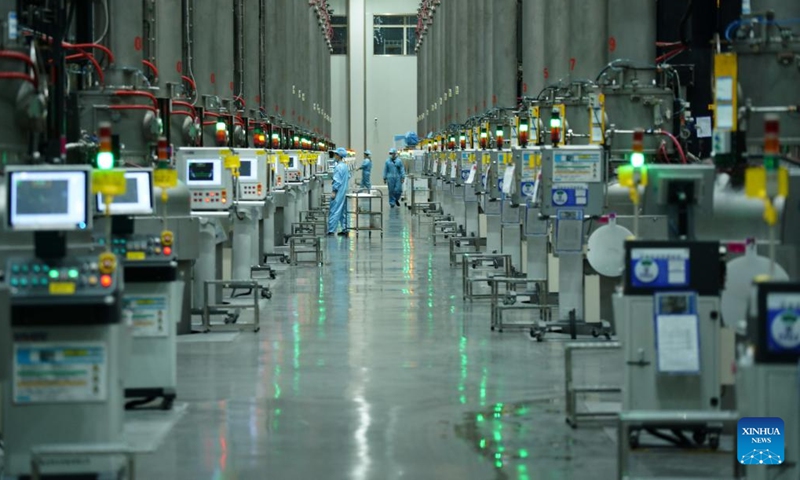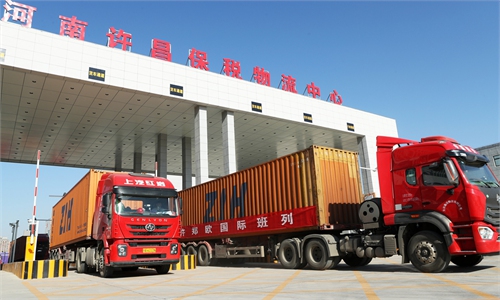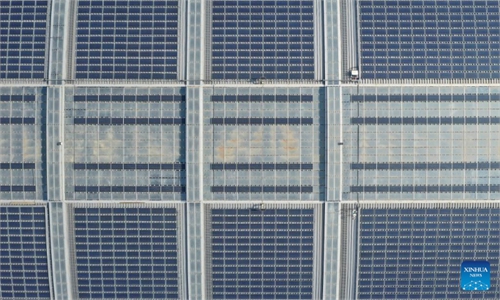China launches trading of world’s first industrial silicon futures to boost risk management

Employees produce single crystalline silicon rods at a new energy company in Xingtai, north China's Hebei Province, Dec. 19, 2022. (Photo: Xinhua)
The trading of the world's first industrial silicon futures started at the Guangzhou Futures Exchange on Thursday, in a move that experts said will help stabilize prices of the metal mostly used in chips and solar panels and enhance the risk management capability of market entities.
A total of five industrial silicon futures contracts were launched, most of which opened higher on the first trading day. The main contract, SI2308, opened more than 3 percent higher at 19,100 yuan ($2,737) per ton, according to data from the exchange.
Trading of industrial silicon options will start on Friday.
The rollout of industrial silicon contracts and options will help stabilize the supply of industrial silicon for a resilient industrial chain, while improving international trade pricing so as to form a Chinese price that matches the country's silicon market scale, according to Wu Chenhui, an independent industry analyst.
As another tool to manage risks, the industrial silicon futures will help hedge price volatility risks, give China more initiative in international silicon metal price setting, and contribute to the growth momentum of new energy and green development, Wu told the Global Times on Thursday.
Domestic financial institutions, including CITIC Futures, Huatai Futures and Galaxy Futures, actively conducted research on industrial silicon futures as well as online and in-person investor education for the development of industrial silicon futures and derivatives.
Silicon metal is a key raw material for producing polysilicon, organosilicon and aluminum-silicon alloys, which are widely used in photovoltaic solar cells, semiconductors, automobiles and construction.
China is the world's largest industrial silicon producer, consumer and exporter, with a market of about 64.4 billion yuan in 2021.
In 2021, the country's output of silicon metal approached 5 million tons, accounting for about 80 percent of the global total. Its consumption was 2.36 million tons, about 57 percent of the global total, according to the Guangzhou Futures Exchange.
However, price volatility is a headache that most market players have experienced for years, as their production was often disrupted due to high raw material prices. This has a negative impact on company growth.
The export price of China's silicon metals has long been lower than other countries as the benchmark price of international trade is mainly based on figures provided by foreign metal institutions.
Due to disruptions amid power shortages in major silicon production regions, including Southwest China's Yunnan and Sichuan provinces, as well as soaring demand from solar power projects, the Chinese price of industrial silicon skyrocketed more than six times to 67,000 yuan per ton in August 2021 but fell to around 20,000 yuan per ton just two months later.
Currently, the price of industrial silicon has stayed around 20,000 yuan per ton, according to data from smm.cn, Shanghai-based non-ferrous metals portal.
"China's production capacity could meet the long-term supply of polysilicon, and along with many enterprises' production expansion, the country's production capacity of polysilicon is expected to reach 2.2 million tons in 2023," Xu Aihua, deputy head of the Silicon Industry of China Nonferrous Metals Industry Association, told the Global Times recently.
The Guangzhou Futures Exchange, the fifth of its kind in China, was established in 2021 with a focus on products related to green and sustainable development.
Hu Zheng, president of the exchange, said that the exchange will develop more futures related to green development, such as electricity, lithium, rare earths, products related to the Guangdong-Hong Kong-Macao Greater Bay Area and the Belt and Road Initiative, as well as those connected with international financial markets, the Xinhua News Agency reported on Thursday.
"The exchange aims to come up with more new energy metal products and actively promote opening-up so as to gradually become a global new energy metal pricing center," Hu said.


